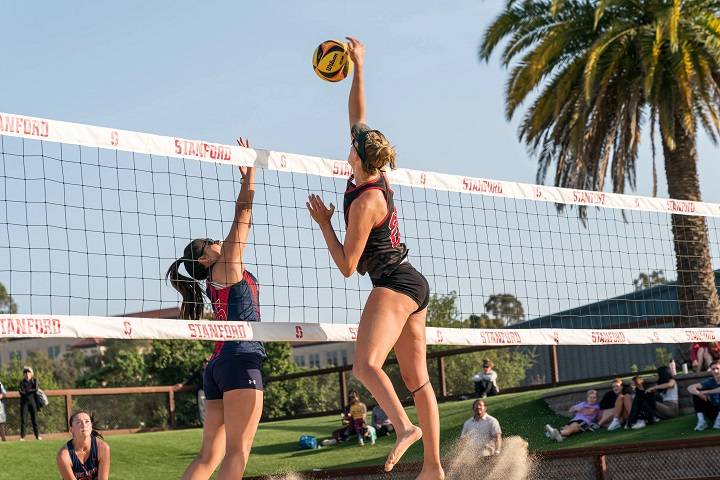Volleyball, a sport that unfolds with the rhythmic pulse of spikes and serves, is renowned for its fast-paced nature and thrilling exchanges. As enthusiasts and athletes delve into the world of volleyball, the question of game duration arises. In this comprehensive exploration, we peel back the layers to understand the intricacies of volleyball match durations, the factors that influence game length, and the nuances that make each contest a unique spectacle.
Understanding Volleyball Match Duration
Set-Based Structure
Sets Defined:
Volleyball matches are organized into sets, each offering a unique dynamic within the overall game. A set represents a segment of the match and is won by the team that first reaches 25 points, provided they have a two-point advantage over their opponents. If the match extends to a fifth set, it is played to 15 points.
Best-of-Five Format:
In most competitive volleyball settings, matches follow a best-of-five sets format. The first team to secure three sets emerges victorious in the match. This structure introduces a layer of unpredictability and strategic maneuvering as teams navigate through the sets.
Rally Scoring System
Every Point Matters:
Volleyball employs a rally scoring system, meaning that a point is scored on every serve, regardless of which team served. This system intensifies the competition, as teams must be proficient in both offense and defense to gain an edge in the match.
Constant Score Changes:
Rally scoring ensures a fluid and dynamic scoreboard, with the lead shifting after every rally. The continuous ebb and flow of points contribute to volleyball matches’ dynamic and unpredictable nature.
The Volleyball Match Journey: Set by Set
First Set: Setting the Tone
Early Momentum:
The first set is often crucial in setting the tone for the match. Teams strive to establish early momentum, gaining a psychological advantage over their opponents. A strong start can influence the trajectory of the entire match.
Adaptability and Tactics:
Coaches and players assess the opponent’s strengths and weaknesses in the opening set. Tactical adjustments and strategic shifts may occur as teams seek to exploit vulnerabilities and gain a foothold in the match.
Subsequent Sets: Momentum Swings
Evolving Strategies:
As the match progresses, teams may adjust their strategies based on the unfolding dynamics. Coaches may make substitutions, alter formations, or implement specific plays to counteract the opponent’s tactics.
Intensity and Drama:
The second and third sets often witness heightened intensity as teams jockey for control. Momentum swings become a defining feature, with each set presenting an opportunity for teams to seize control or mount comebacks.
Fourth Set (if Necessary): Decisive Moments
Turning Point:
If the match extends to a fourth set, it becomes a pivotal juncture. Teams on the brink of victory aim to close out the match, while those trailing fight to force a decisive fifth set. The fourth set is laden with critical moments that can determine the outcome.
Fatigue and Endurance:
Fatigue can become a factor in the fourth set, especially in closely contested matches. Endurance, both physical and mental, plays a significant role as players strive to maintain peak performance in the latter stages of the match.
Fifth Set (if Necessary): The Sprint to the Finish
Race to 15 Points:
In a best-of-five format, the fifth set is a sprint to 15 points. The team that reaches 15 points with a two-point advantage emerges victorious. The condensed nature of the fifth set adds an element of urgency and excitement, as every point becomes crucial.
Nail-Biting Conclusions:
Fifth sets are known for their nail-biting conclusions, often featuring closely contested rallies and dramatic final points. The short format heightens the drama, and the team that maintains composure under pressure typically prevails.
Factors Influencing Match Duration
Team Playing Styles
Pace of Play:
Teams with a fast-paced, aggressive playing style may complete sets more quickly. Quick transitions from defense to offense and efficient execution of plays contribute to a brisk pace of play.
Defensive Resilience:
Defensively-oriented teams, adept at prolonging rallies and digging opponents’ attacks, may extend the duration of sets. The ability to withstand offensive pressure and force opponents into errors can lead to more extended rallies.
Strategic Timeouts and Substitutions
Strategic Breaks:
Coaches strategically use timeouts to regroup their teams, disrupt opponents’ momentum, or provide crucial instructions. The timing and impact of timeouts can influence the tempo of the match.
Player Rotations:
Substitutions and player rotations can impact the flow of the game. Coaches may make tactical substitutions to introduce specific skills or adjust player positioning to exploit matchups.
Strategies for Success in Volleyball Matches
Consistent Serving and Passing
Serve Reception Excellence:
Consistent serve reception is fundamental to initiating effective attacks. Teams that excel in serve reception set the stage for seamless offensive plays, reducing the likelihood of errors.
Strategic Serving:
Strategic serving involves targeting specific opponents or areas of the court to disrupt the opponent’s offensive schemes. Well-placed serves force opponents into challenging situations, creating opportunities for defensive plays.
Front-Row Dominance and Blocking
Net Presence:
Teams with strong front-row players who excel in blocking create a formidable defensive barrier. Effective blocking disrupts opponents’ attacks, limits scoring opportunities, and instills confidence in the defensive unit.
Timing and Technique:
Successful blocking requires precise timing, proper technique, and coordinated efforts among front-row players. Teams that master the art of blocking often gain a decisive advantage in controlling the net.
Dynamic Offensive Strategies
Versatile Attacks:
Offensive versatility is a hallmark of successful volleyball teams. Varied attack strategies, including quick sets, combination plays, and powerful spikes from different positions, keep opponents guessing and enhance scoring opportunities.
Adaptability in Offense:
The ability to adapt offensive strategies based on the opponent’s defensive schemes is crucial. Coaches may employ diverse offensive tactics to exploit weaknesses and create mismatches.
Scoring Milestones and Achievements
Individual and Team Records
Point Milestones:
Players often achieve significant point milestones during their careers. Whether reaching a specific number of career points or setting single-match scoring records, these milestones contribute to a player’s legacy.
Team Achievements:
Teams may achieve historic feats, such as consecutive set victories, tournament-winning streaks, or record-setting performances. These collective achievements become part of a team’s legacy in the annals of volleyball history.
Championship Triumphs
Tournament Victories:
The ultimate goal for volleyball teams is often championship triumphs. Winning prestigious tournaments and claiming titles represent the culmination of dedicated teamwork, strategic prowess, and individual contributions.
MVP Accolades:
Players who excel in crucial moments and significantly contribute to their teams may earn Most Valuable Player (MVP) accolades. These awards recognize exceptional individual performances throughout the tournament.
Related Post:
- Touchdown Tales: Exploring the Heart of Football
- Softball: A Dynamic and Inclusive Sport Celebrating its Rich Legacy
- Pickleball: A Paddle-Powered Revolution in the World of Racquet Sports
In the realm of volleyball, a game’s duration extends beyond the clock’s ticking. It is a dynamic interplay of skill, strategy, and endurance, where each set contributes to the evolving narrative of a match. Whether teams engage in a swift three-set battle or endure the intensity of a five-set marathon, the essence of volleyball lies in the pursuit of excellence on the court.
As players execute precision serves, crafty sets, and thunderous spikes, and as teams celebrate hard-fought points and strategic victories, the tempo of volleyball emerges as a symphony of athletic prowess. So, whether you’re a seasoned volleyball enthusiast or a newcomer to the sport, the question of how long a volleyball game lasts unveils a captivating journey where every rally, every point, and every set adds to the rich tapestry of volleyball’s enduring appeal.



